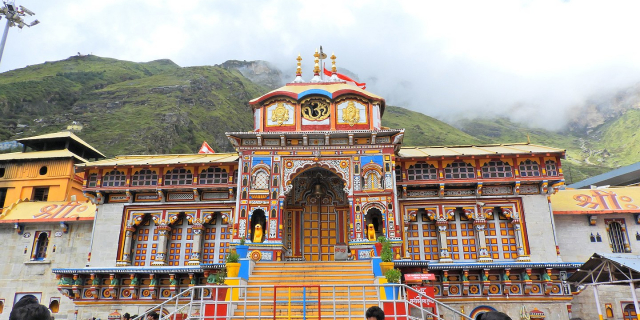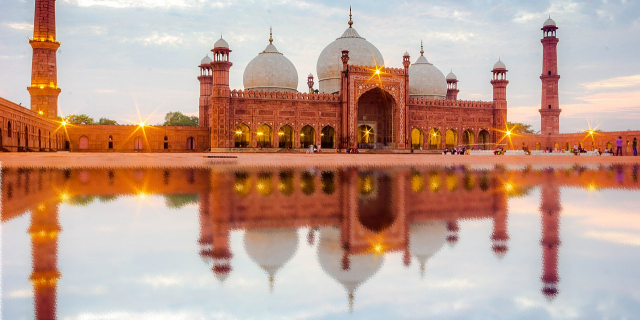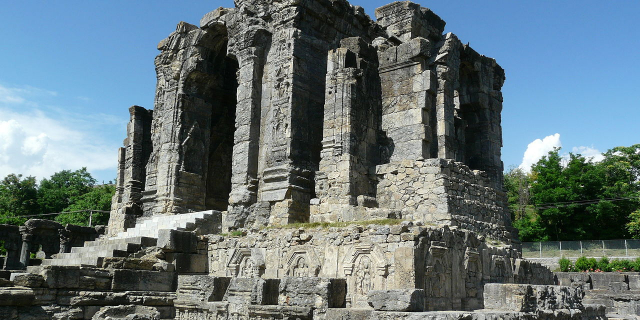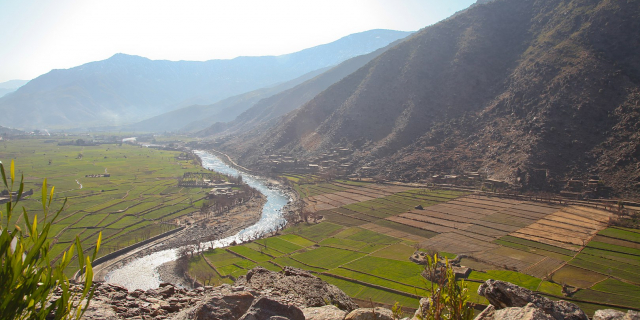Uttarakhand
Context of Uttarakhand
Uttarakhand (English: , or ; Hindi: ['ʊt̪ːərɑːkʰəɳɖ], lit. 'Northern Land'), also known as Uttaranchal (English: ; the official name until 2007), is a state in the northern India. It is often referred to as the "Devbhumi" (lit. 'Land of the Gods') due to its religious significance and numerous Hindu temples and pilgrimage centres found throughout the state. Uttarakhand is known for the natural environment of the Himalayas, the Bhabar and the Terai regions. It borders the Tibet Autonomous Region of China to the north; the Sudurpashchim Province of Nepal to the east; the Indian states of Uttar Prad...Read more
Uttarakhand (English: , or ; Hindi: ['ʊt̪ːərɑːkʰəɳɖ], lit. 'Northern Land'), also known as Uttaranchal (English: ; the official name until 2007), is a state in the northern India. It is often referred to as the "Devbhumi" (lit. 'Land of the Gods') due to its religious significance and numerous Hindu temples and pilgrimage centres found throughout the state. Uttarakhand is known for the natural environment of the Himalayas, the Bhabar and the Terai regions. It borders the Tibet Autonomous Region of China to the north; the Sudurpashchim Province of Nepal to the east; the Indian states of Uttar Pradesh to the south and Himachal Pradesh to the west and north-west. The state is divided into two divisions, Garhwal and Kumaon, with a total of 13 districts. The winter capital of Uttarakhand is Dehradun, the largest city of the state, which is a rail head. Gairsain, a town in Chamoli district, is the summer capital of Uttarakhand declared on 5 March 2020. The High Court of the state is located in Nainital, but is to be moved to Haldwani in future.
Archaeological evidence supports the existence of humans in the region since prehistoric times. The region formed a part of the Uttarakuru Kingdom during the Vedic age of Ancient India. Among the first major dynasties of Kumaon were the Kunindas in the second century BCE who practiced an early form of Shaivism. Ashokan edicts at Kalsi show the early presence of Buddhism in this region. During the medieval period, the region was consolidated under the Katyuri rulers of Kumaon also known as 'Kurmanchal Kingdom'. After the fall of Katyuris, the region was divided into the Kumaon Kingdom and the Garhwal Kingdom. In 1816, most of modern Uttarakhand was ceded to the British as part of the Treaty of Sugauli. Although the erstwhile hill kingdoms of Garhwal and Kumaon were traditional rivals, the proximity of different neighbouring ethnic groups and the inseparable and complementary nature of their geography, economy, culture, language, and traditions created strong bonds between the two regions, which further strengthened during the Uttarakhand movement for statehood in the 1990s.
The natives of the state are generally called Uttarakhandi, or more specifically either Garhwali or Kumaoni by their region of origin. According to the 2011 Census of India, Uttarakhand has a population of 10,086,292, making it the 20th most populous state in India.
More about Uttarakhand
- Population 10086292
- Area 53566
Ancient rock paintings, rock shelters, paleolithic age stone tools (hundreds of thousands of years old), and megaliths provide evidence that the mountains of the region have been inhabited since prehistoric times. There are also archaeological remains that show the existence of early Vedic (c. 1500 BCE) practices in the area.[1] The Pauravas, Khasas, Kiratas, Nandas, Mauryas, Kushanas, Kunindas, Guptas, Karkotas, Palas, Gurjara-Pratiharas, Katyuris, Raikas, Chands, Parmars or Panwars, Mallas, Shahs and the British have ruled Uttarakhand in turns.[2]
Among the first major dynasties of Garhwal and Kumaon were the Kunindas in the second century BCE who practised an early form of Shaivism and traded salt with Western Tibet. It is evident from the Ashokan edict at Kalsi in Western Garhwal that Buddhism made inroads in this region. Shamanic Hindu practices deviating from Hindu orthodoxy also persisted here. However, Garhwal and Kumaon were restored to nominal Vedic Hindu rule due to the travels of Shankaracharya and the arrival of migrants from the plains.[citation needed]
...Read moreRead lessAncient rock paintings, rock shelters, paleolithic age stone tools (hundreds of thousands of years old), and megaliths provide evidence that the mountains of the region have been inhabited since prehistoric times. There are also archaeological remains that show the existence of early Vedic (c. 1500 BCE) practices in the area.[1] The Pauravas, Khasas, Kiratas, Nandas, Mauryas, Kushanas, Kunindas, Guptas, Karkotas, Palas, Gurjara-Pratiharas, Katyuris, Raikas, Chands, Parmars or Panwars, Mallas, Shahs and the British have ruled Uttarakhand in turns.[2]
Among the first major dynasties of Garhwal and Kumaon were the Kunindas in the second century BCE who practised an early form of Shaivism and traded salt with Western Tibet. It is evident from the Ashokan edict at Kalsi in Western Garhwal that Buddhism made inroads in this region. Shamanic Hindu practices deviating from Hindu orthodoxy also persisted here. However, Garhwal and Kumaon were restored to nominal Vedic Hindu rule due to the travels of Shankaracharya and the arrival of migrants from the plains.[citation needed]
Katarmal Sun Temple constructed by the Katyuri Kings in the 9th century CEJageshwar Temples Complex are a group of over 100 Hindu temples dated between 7th and 12th century.Between the 4th and 14th centuries, the Katyuri dynasty dominated lands of varying extent from the Katyur valley (modern-day Baijnath) in Kumaon. The historically significant temples at Jageshwar are believed to have been built by the Katyuris and later remodelled by the Chands. Other peoples of the Tibeto-Burman group known as Kirata are thought to have settled in the northern highlands as well as in pockets throughout the region, and are believed to be ancestors of the modern day Bhotiya, Raji, Jad, and Banrawat people.[3]
 Rope bridge across Alaknanda River at Srinagar, 1784-94 – the capital of the Garhwal Kingdom
Rope bridge across Alaknanda River at Srinagar, 1784-94 – the capital of the Garhwal Kingdom Fort of Champawat, 1815 – the first capital of the Chand kings of Kumaon Kingdom
Fort of Champawat, 1815 – the first capital of the Chand kings of Kumaon KingdomBy the medieval period, the region was consolidated under the Garhwal Kingdom in the west and the Kumaon Kingdom in the east. During this period, learning and new forms of painting (the Pahari school of art) developed.[4] Modern-day Garhwal was likewise unified under the rule of Parmars who, along with many Brahmins and Rajputs, also arrived from the plains.[5] In 1791, the expanding Gorkha Empire of Nepal overran Almora, the seat of the Kumaon Kingdom. It was annexed to the Kingdom of Nepal by Amar Singh Thapa. In 1803, the Garhwal Kingdom also fell to the Gurkhas. After the Anglo-Nepalese War, this region was ceded to the British as part of the Treaty of Sugauli and the erstwhile Kumaon Kingdom along with the eastern region of Garhwal Kingdom was merged with the Ceded and Conquered Provinces. In 1816, the Garhwal Kingdom was re-established from a smaller region in Tehri as a princely state. In the southern part of Uttarakhand in Haridwar District (earlier part of saharanpur till 1988), the dominance and kingship (rajya) was exercises by Gujar chiefs, the area was under control of Parmar (Panwar or Khubars) Gujars in eastern Saharanpur including Haridwar in kingship of Raja Sabha Chandra of Jabarhera (Jhabrera). Gujars of the Khubar (Panwar) gotra held more than 500 villages there in upper Doab, and that situation was confirmed in 1759 in a grant by a Rohilla governor of 505 villages and 31 hamlets to one Manohar Singh Gujar (written in some records as Raja Nahar Singh son of Sabha Chandra). In 1792 Ram Dayal and his son Sawai Singh were ruling the area but due to some family reasons Ramdayal left Jhabrera and went to Landhaura village, now some villages were under control of Raja Ramdayal singh at Landhaura and some under his son Sawai Singh at Jhabrera. Hence, there were two branches of Jabarhera estate (riyasat) main branch at Jabarhera and second one at Landhaura, both father and son were ruling simultaneously without any conflicts till death of Raja Sawai Singh of Jabarhera in 1803. After death of Sawai Singh total control of powers transferred to Ram Dayal Singh at Landhaura, but some villages were given to descendants of Sawai Singh and her widow to collect revenue. By 1803 the Landhaura villages numbered 794 under Raja Ram Dayal Singh. Raja Ram Dayal Singh died on 29 March 1813.[6] These holdings, at least those in the original grant made by the Rohilla governor, were initially recognized by the British in land settlements concluded with Ram Dayal and his heirs. As the years passed, more and more settlements appear to have been made with the village communities, however, and by 1850 little remained of the once vast estate of the Landhaura Khübars.[7]
 Uttarakhand as a part of the Ceded and Conquered Provinces
Uttarakhand as a part of the Ceded and Conquered ProvincesAfter India attained independence from the British, the Garhwal Kingdom was merged into the state of Uttar Pradesh, where Uttarakhand composed the Garhwal and Kumaon Divisions.[8] Until 1998, Uttarakhand was the name most commonly used to refer to the region, as various political groups, including the Uttarakhand Kranti Dal (Uttarakhand Revolutionary Party), began agitating for separate statehood under its banner. Although the erstwhile hill kingdoms of Garhwal and Kumaon were traditional rivals the inseparable and complementary nature of their geography, economy, culture, language, and traditions created strong bonds between the two regions.[9] These bonds formed the basis of the new political identity of Uttarakhand, which gained significant momentum in 1994, when demand for separate statehood achieved almost unanimous acceptance among both the local populace and national political parties.[10]
The most notable incident during this period was the Rampur Tiraha firing case on the night of 1 October 1994, which led to a public uproar.[11] On 24 September 1998, the Uttar Pradesh Legislative Assembly and Uttar Pradesh Legislative Council passed the Uttar Pradesh Reorganisation Bill, which began the process of forming a new state.[12] Two years later the Parliament of India passed the Uttar Pradesh Reorganisation Act, 2000 and thus, on 9 November 2000, Uttarakhand became the 27th state of the Republic of India.[13]
 Uttarakhand as a part of Uttar Pradesh, 1950–2000
Uttarakhand as a part of Uttar Pradesh, 1950–2000Uttarakhand is also well known for the mass agitation of the 1970s that led to the formation of the Chipko environmental movement[14] and other social movements. Though primarily a livelihood movement rather than a forest conservation movement, it went on to become a rallying point for many future environmentalists, environmental protests, and movements the world over and created a precedent for non-violent protest.[15] It stirred up the existing civil society in India, which began to address the issues of tribal and marginalised people. So much so that, a quarter of a century later, India Today mentioned the people behind the "forest satyagraha" of the Chipko movement as among "100 people who shaped India".[16] One of Chipko's most salient features was the mass participation of female villagers.[17] It was largely female activists that played pivotal role in the movement. Gaura Devi was the leading activist who started this movement, other participants were Chandi Prasad Bhatt, Sunderlal Bahuguna, and Ghanshyam Raturi, the popular Chipko poet.[18]
^ "Uttarakhand". Encyclopædia Britannica, Inc. Archived from the original on 2 July 2012. Retrieved 17 July 2012. ^ Cite error: The named reference autogenerated2001 was invoked but never defined (see the help page). ^ Saklani, D. P. (1998). Ancient communities of the Himalaya. New Delhi: Indus Pub. Co. ^ Pande, B. D. (1993). History of Kumaun: English version of "Kumaun Ka Itihas". Almora, U.P., India: Shyam Prakashan: Shree Almora Book Depot. ^ Rawat, A. S. (1989). History of Garhwal, 1358–1947: an erstwhile kingdom in the Himalayas. New Delhi: Indus Pub. Co. ^ Atkinson, Edwin Thomas (1875). Statistical, Descriptive and Historical Account of the North-Western Provinces of India: 2.:Meerut division part 1. North-Western Provinces Government. ^ Raheja, Gloria Goodwin (June 1988). The Poison in the Gift: Ritual, Prestation, and the Dominant Caste in a North Indian Village. University of Chicago Press. ISBN 978-0-226-70728-0. ^ Saklani, A. (1987). The history of a Himalayan princely state: change, conflicts and awakening: an interpretative history of princely state of Tehri Garhwal, U.P., A.D. 1815 to 1949 A.D. (1st ed.). Delhi: Durga Publications. ^ Aggarwal, J. C., Agrawal, S. P., & Gupta, S. S. (Eds.). (1995). Uttarakhand: past, present, and future. New Delhi: Concept Pub. Co. ^ Kumar, P. (2000). The Uttarakhand Movement: Construction of a Regional Identity. New Delhi: Kanishka Publishers. ^ "HC quashes CBI report on Rampur Tiraha firing". The Times of India. 31 July 2003. Archived from the original on 20 October 2012. Retrieved 28 July 2012. ^ Reorganisation Bill passed by UP Govt Archived 7 September 2009 at the Wayback Machine The Indian Express, 24 September 1998. ^ Bhaskar, Arushi (9 November 2022). "Uttarakhand Foundation Day: The long struggle for the hill state". The Indian Express. Retrieved 31 December 2022. ^ Guha, R. (2000). The unquiet woods: ecological change and peasant resistance in the Himalaya (Expanded ed.). Berkeley, Calif.: University of California Press. ^ Robbins, Paul (9 August 2004). Political Ecology: A Critical Introduction. Wiley. ISBN 978-1-4051-0266-7. ^ Agarwal, Anil. "The Chipko Movement". India Today. Archived from the original on 23 August 2014. Retrieved 29 July 2012. ^ Mishra, A., & Tripathi, (1978). Chipko movement: Uttaranchal women's bid to save forest wealth. New Delhi: People's Action/Gandhi Book House. ^ "Chipko Movement, India". International Institute for Sustainable Development. Archived from the original on 21 March 2012. Retrieved 29 July 2012.































